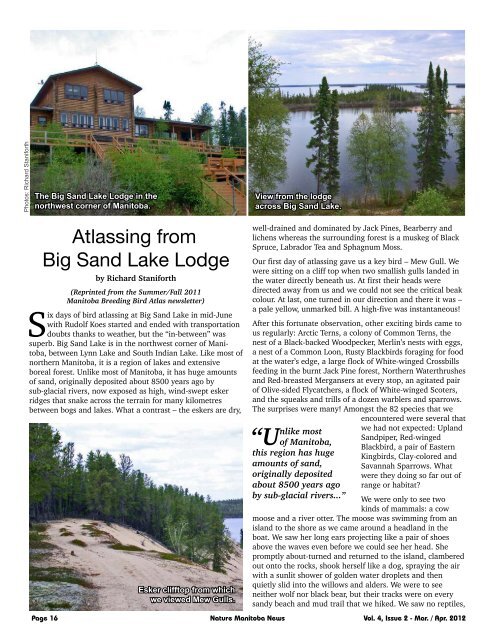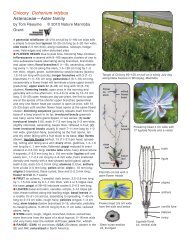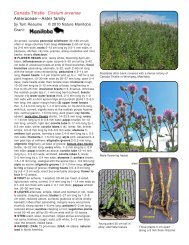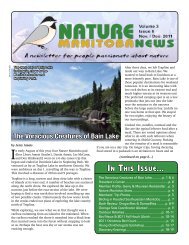View/Download Newsletter (.pdf, 5.21 MB) - Nature Manitoba
View/Download Newsletter (.pdf, 5.21 MB) - Nature Manitoba
View/Download Newsletter (.pdf, 5.21 MB) - Nature Manitoba
Create successful ePaper yourself
Turn your PDF publications into a flip-book with our unique Google optimized e-Paper software.
Photos: Richard Staniforth<br />
The Big Sand Lake Lodge in the<br />
northwest corner of <strong>Manitoba</strong>.<br />
Atlassing from<br />
Big Sand Lake Lodge<br />
by Richard Staniforth<br />
(Reprinted from the Summer/Fall 2011<br />
<strong>Manitoba</strong> Breeding Bird Atlas newsletter)<br />
Six days of bird atlassing at Big Sand Lake in mid-June<br />
with Rudolf Koes started and ended with transportation<br />
doubts thanks to weather, but the “in-between” was<br />
superb. Big Sand Lake is in the northwest corner of <strong>Manitoba</strong>,<br />
between Lynn Lake and South Indian Lake. Like most of<br />
northern <strong>Manitoba</strong>, it is a region of lakes and extensive<br />
boreal forest. Unlike most of <strong>Manitoba</strong>, it has huge amounts<br />
of sand, originally deposited about 8500 years ago by<br />
sub-glacial rivers, now exposed as high, wind-swept esker<br />
ridges that snake across the terrain for many kilometres<br />
between bogs and lakes. What a contrast – the eskers are dry,<br />
Esker clifftop from which<br />
we viewed Mew Gulls.<br />
<strong>View</strong> from the lodge<br />
across Big Sand Lake.<br />
well-drained and dominated by Jack Pines, Bearberry and<br />
lichens whereas the surrounding forest is a muskeg of Black<br />
Spruce, Labrador Tea and Sphagnum Moss.<br />
Our first day of atlassing gave us a key bird – Mew Gull. We<br />
were sitting on a cliff top when two smallish gulls landed in<br />
the water directly beneath us. At first their heads were<br />
directed away from us and we could not see the critical beak<br />
colour. At last, one turned in our direction and there it was –<br />
a pale yellow, unmarked bill. A high-five was instantaneous!<br />
After this fortunate observation, other exciting birds came to<br />
us regularly: Arctic Terns, a colony of Common Terns, the<br />
nest of a Black-backed Woodpecker, Merlin’s nests with eggs,<br />
a nest of a Common Loon, Rusty Blackbirds foraging for food<br />
at the water’s edge, a large flock of White-winged Crossbills<br />
feeding in the burnt Jack Pine forest, Northern Waterthrushes<br />
and Red-breasted Mergansers at every stop, an agitated pair<br />
of Olive-sided Flycatchers, a flock of White-winged Scoters,<br />
and the squeaks and trills of a dozen warblers and sparrows.<br />
The surprises were many! Amongst the 82 species that we<br />
encountered were several that<br />
nlike most<br />
“Uof <strong>Manitoba</strong>,<br />
this region has huge<br />
amounts of sand,<br />
originally deposited<br />
about 8500 years ago<br />
by sub-glacial rivers...”<br />
we had not expected: Upland<br />
Sandpiper, Red-winged<br />
Blackbird, a pair of Eastern<br />
Kingbirds, Clay-colored and<br />
Savannah Sparrows. What<br />
were they doing so far out of<br />
range or habitat?<br />
We were only to see two<br />
kinds of mammals: a cow<br />
moose and a river otter. The moose was swimming from an<br />
island to the shore as we came around a headland in the<br />
boat. We saw her long ears projecting like a pair of shoes<br />
above the waves even before we could see her head. She<br />
promptly about-turned and returned to the island, clambered<br />
out onto the rocks, shook herself like a dog, spraying the air<br />
with a sunlit shower of golden water droplets and then<br />
quietly slid into the willows and alders. We were to see<br />
neither wolf nor black bear, but their tracks were on every<br />
sandy beach and mud trail that we hiked. We saw no reptiles,<br />
Page 16 <strong>Nature</strong> <strong>Manitoba</strong> News Vol. 4, Issue 2 - Mar. / Apr. 2012





